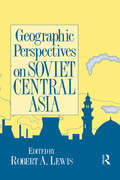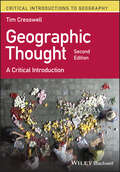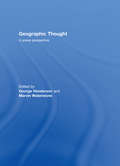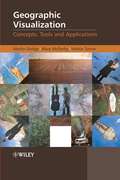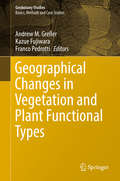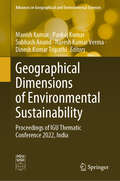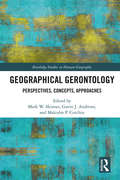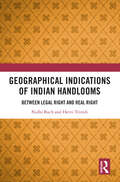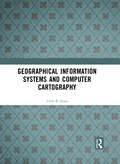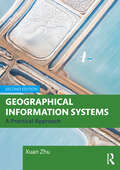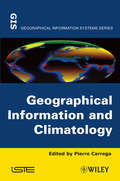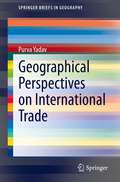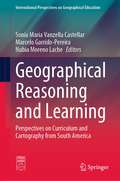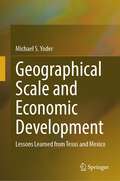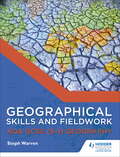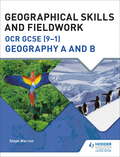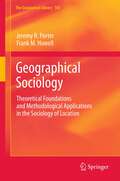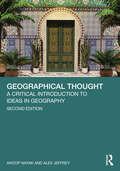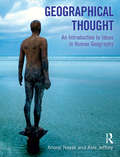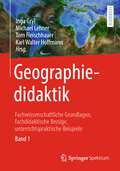- Table View
- List View
Geographic Perspectives on Soviet Central Asia
by Robert A. LewisIn a unique survey, based on new census data, Geographic Perspectives on Soviet Central Asia highlights the region's geographic, economic and ecological problems since 1945. Painting a grim picture, this book investigates how the combination of rapid population growth and declining per capita investment is causing economic conditions to slide in rural areas and encouraging an ecological catastrophe. The authors discuss the effects of low rural out-migration, and show that at current growth rates the rural working-age population will double with each generation. Unprecedented in a developed country, this is causing the region to become more rather than less rural. Soviet Central Asia is an area of low productivity, and the book considers the lack of support from Soviet central government to the region. Wishing to maximise their return to capital and labour, the government is concentrating its investment in the European West and directing insufficient funds for a growing workforce in Central Asia. Soviet Central Asia also faces grave ecological problems; the declining level of the Aral Sea, extensive soil salinization and water pollution, all largely due to past attempts at irrigation. The authors consider the effect of these disasters on the area, and look to future possibilities in this very important region of the world.
Geographic Thought: A Critical Introduction (Critical Introductions to Geography)
by Tim CresswellGeographic Thought An accessible and engaging introduction to geographic thought In the newly expanded Second Edition of Geographic Thought: A Critical Introduction, renowned scholar Tim Cresswell delivers a thoroughly up-to-date and accessible examination of the major thinkers and key theoretical developments in the field. Coverage of the complete range of the development of theoretical knowledge—from ancient geography to contemporary theory—appears alongside treatments of the influence of Darwin and Marx, the emergence of anarchist geographies, the impact of feminism, and myriad other central bodies of thought. This latest edition also includes new chapters on physical geography and theory, postcolonialism and decoloniality, and black geographies. The author emphasizes the importance of geographic thought and its relevance to our understanding of what it means to be human and to the people, places, and cultures of the world in which we live. This new edition contains: New examples throughout consisting of contemporary research from a wider range of geographical contexts and by geographers from diverse backgrounds Comprehensive explorations of physical geography that combine updated coverage from the first edition with brand new material Updated discussions of spatial science and quantitative methods that include considerations of the role of place and specificity in quantitative work In-depth examinations of the Anthropocene, the uses of assemblage theory, and the emergence of the GeoHumanities. Perfect for students of undergraduate and graduate courses in geographic thought, Geographic Thought: A Critical Introduction will also earn a place in the libraries of students and scholars researching the history and philosophy of geography, as well as practicing geographers.
Geographic Thought: A Praxis Perspective
by George Henderson Marvin WaterstoneWithout social movements and wider struggles for progressive social change, the field of Geography would lack much of its contemporary relevance and vibrancy. Moreover, these struggles and the geographical scholarship that engages with them have changed the philosophical underpinnings of the discipline and have inflected the quest for geographical knowledge with a sense not only of urgency but also hope. This reader, intended for advanced undergraduate and beginning graduate courses in Geographic Thought, is at once an analysis of Geography’s theoretical and practical concerns and an encounter with grounded political struggles. This reader offers a fresh approach to learning about Geographic Thought by showing, through concrete examples and detailed editorial essays, how the discipline has been forever altered by the rise of progressive social struggles. Structured to aid student understanding, the anthology presents substantive main and part introductory essays and features more than two dozen unabridged published works by leading scholars that emphatically articulate geographic thought to progressive social change. Each section is introduced with an explanation of how the following pieces fit into the broader context of geographic work amidst the socially progressive struggles that have altered social relations in various parts of the world over the last half-century or so. Doubly, it places this work in the context of the larger goals of social struggles to frame or reframe rights, justice, and ethics. Geographic Thought provides readers with insights into the encounters between scholarship and practice and aims to prompt debates over how social and geographical knowledges arise from the context of social struggles and how these knowledges might be redirected at those contexts in constructive, evaluative ways. The reader is unique not only in knowing Geographic Thought through its progressive political attachments, instead of through a series of abstract "isms", but in gathering together salient works by geographers as well as scholars in cognate fields, such as Nancy Fraser, Chantal Mouffe, Iris Marion Young, and Jack Kloppenberg, whose own engagements have proved lasting and influential. For researchers and students interested in the connections between theoretically informed work and the possibilities for bettering people’s everyday lives, this book provides an innovative and compelling argument for why Geographic Thought is valuable and necessary.
Geographic Visualization
by Martin Dodge Mary Mcderby Martin TurnerGeographic Visualization: Concepts, Tools and Applications is a 'state-of-the-art' review of the latest developments in the subject. It examines how new concepts, methods and tools can be creatively applied to solve problems relevant to a wide range of topics. The text covers the impact of three-dimensional displays on user interaction along with the potentialities in animation and clearly explains how to create temporally sensitive visualizations. It also explores the potential for handling mobile data and representing uncertainty; as well as the role of participatory visualization systems and exploratory methods.Hallmark Features: An introduction to the diverse forms of geographic visualization which draws upon a number of theoretical perspectives and disciplines to provide an insightful commentary on new methods, techniques and tools.Richly illustrated in full colour throughout, including numerous relevant case studies and accessible discussions of important visualization concepts to enable clearer understanding for non-technical audiences.Chapters are written by leading scholars and researchers in a range of cognate fields, including, cartography, GIScience, architecture, art, urban planning and computer graphics with case studies drawn from Europe, North America and AustraliaThis book is an invaluable resource for all graduate students, researchers and professionals working in the geographic information sector, computer graphics and cartography.
Geographical Changes in Vegetation and Plant Functional Types (Geobotany Studies)
by Kazue Fujiwara Franco Pedrotti Andrew M. GrellerThis book presents studies on current vegetation topics, from polar to tropical regions. It is a festschrift to mark the 70th birthday of Prof. Elgene O. Box, who has studied vegetation all over the world, both through fieldwork and modeling. It reflects a number of his interests, including basic ecological plant forms (cf ‘plant functional types’), temperate-zone forests, and evergreen versus seasonal patterns. Section 1 discusses the concept of vegetation series, while Section 2 has two global-scale chapters on plant functional traits and whether they are related more to climate or phylogeny. Section 3 has nine chapters focusing on vegetation history, regional vegetation, and how these have influenced current species organizations and distributions. Regions treated include Russia, China, the USA, Mexico and Mediterranean areas. Lastly, Section 4 addresses aspects of vegetation change and plant ecology. Every chapter in this unique book offers original ideas on the topic of vegetation, as the authors are assembled from a world-wide population of leading vegetational ecologists, whose interests range from local communities to global theoretical questions.
Geographical Dimensions of Environmental Sustainability: Proceedings of IGU Thematic Conference 2022, India (Advances in Geographical and Environmental Sciences)
by Manish Kumar Pankaj Kumar Subhash Anand Dinesh Kumar Tripathi Naresh Kumar VermaThis book presents selected papers from the International Geographical Union (IGU) Thematic Conference 2022, which was held at the Central University of Haryana, Mahendragarh, India, November 24–25, 2022. The theme of the conference was Sustainability, Future Earth, and Humanities: Opportunities and Challenges. Within the context of the physical environment, the book explores advanced research and innovative methodologies that illuminate significant discoveries pertaining to comprehensive perspectives on sustainability. Environmental sustainability is a critical global concern that revolves around the responsible use and preservation of natural resources to meet present needs without compromising the ability of future generations to meet their own needs. It encompasses various dimensions that impact the health and resilience of our planet. Geographical factors play a crucial role in determining the challenges and opportunities associated with sustainability, offering valuable insights into the interconnectedness between nature and society. These insights are fundamental to understand environmental sustainability including ecosystem diversity, climate and weather patterns, land use and urbanization, water resources, natural hazards and vulnerability, resource distribution, transportation and connectivity, coastal and marine environments, political and social boundaries, and environmental justice. Understanding and integrating these geographical dimensions into environmental sustainability initiatives can lead to more effective and context-specific strategies to safeguard our planet's health and promote a harmonious coexistence between nature and human society. It requires interdisciplinary collaboration, international cooperation, and a shared commitment to protect and nurture the Earth for current and future generations. This book covers a broad range of issues, with an emphasis on how to create a physically and socially sustainable environment. In addition, this book provides comprehensive investigations of a range of subjects, including climate change, environmental risk assessment, climatic hazards, resource exploration, water resource management, seismic analysis, green synthesis, ground thermal regime, and glacial dynamics, among others.
Geographical Gerontology: Perspectives, Concepts, Approaches (Routledge Studies in Human Geography)
by Malcolm P. Cutchin Mark W. Skinner Gavin J. AndrewsUnderstanding where ageing occurs, how it is experienced by different people in different places, and in what ways it is transforming our communities, economies and societies at all levels has become crucial for the development of informed research, policy and programmes. <P><P>This book focuses on the interdisciplinary field of study – geographical gerontology – that addresses these issues. With contributions from more than 30 leading geographers and gerontologists, the book examines the scope and depth of geographical perspectives, concepts and approaches applied to the study of ageing, old age and older populations. The book features 25 chapters organized into five parts that cover the field’s theoretical traditions and intellectual evolution; the contributions of key disciplinary perspectives from population geography, social and cultural geography, health geography, urban planning and environmental studies; the scales of inquiry within geographical gerontology from the global to the embodied; the thematic breadth of contemporary issues of interest that define the field (places, spaces and landscapes of ageing); and a discussion about challenges, opportunities and agendas for future developments in geography and gerontology. <P><P>This book provides the first comprehensive foundation of knowledge about the state of the art of geographical gerontology that will be of interest to scholars of ageing around the world.
Geographical Indications of Indian Handlooms: Between Legal Right and Real Right
by Nidhi Buch Hetvi TrivediThis book presents a comprehensive analysis of Geographical Indications (GI) in the Indian context with particular reference to the handloom sector. It discusses themes such as the rationale of GI as IP (intellectual property); the domestic position on GIs; GI protection under various international instruments; handlooms from Gujarat and their GI journey; the efficacy of GIs; and GI structure for handlooms. The volume fills the gap between law and policies and recommends the implementation of an efficient legal system. It highlights the status of Indian handlooms, a sector that represents the country’s cultural heritage and supports a range of livelihoods. We examine India’s GI protection system with its diverse cultures and explore how GI can help recognize, support and promote these products to bring socio-economic benefits. The work documents policy measures undertaken for the revival, restructuring and promotion of Indian handlooms and handicrafts, and will serve as an important intervention in Indian law on GI. An investigative study that evaluates the current law and policy on GI protection through detailed case studies and empirical research on select Indian handlooms, this book will be useful to scholars and researchers of geography, economics, development studies, sociology, law and public policy. It will also interest policymakers, legal practitioners, textile and handloom professionals, design and business administration institutes, media, arts and crafts museums and civil society organizations working on handlooms or in intellectual property.
Geographical Information Retrieval in Textual Corpora
by Christian SallaberryThis book addresses the field of geographic information extraction and retrieval from textual documents. Geographic information retrieval is a rapidly emerging subject, a trend fostered by the growing power of the Internet and the emerging possibilities of data dissemination.After positioning his work in this field in Chapter 1, the author makes proposals in the following two chapters. Chapter 2 focuses on spatial and temporal information indexing and retrieval in corpora of textual documents. Propositions for both spatial and temporal information retrieval (IR) are made. Chapter 3 tackles the use of generalized spatial and temporal indexes, which are produced from there in the framework of multi-criteria IR. Geographic IR (GIR) is discussed at length, since this IR combines the criteria of spatial, temporal and thematic research.The author provides a rich bibliographical study of the current approaches focused on the modeling and retrieval of spatial and temporal information in textual documents, and similarity measures developed thus far in the literature.The book concludes with a broad perspective of the remaining scientific challenges. Several areas of research are discussed, such as integration of a domain-based ontology, modeling of spatial footprints from the interpretation of spatial relation, and parsing of relations between features deemed relevant within a document resulting from a GIR process. Contents Foreword, Christophe Claramunt.1. Access by Geographic Content to Textual Corpora: What Orientations ?2. Spatial and Temporal Information Retrieval in Textual Corpora.3. Multicriteria Information Retrieval in Textual Corpora.4. General Conclusion. About the Authors Christian Sallaberry is currently Assistant Professor at the Law, Economics and Management Faculty in Pau, France. His current research interests are in the fields of geographical information retrieval (GIR) in textual corpora: spatial, temporal and thematic information recognition, analyzing, indexing and retrieval. He is interested in spatial, temporal and thematic criteria combinations within a GIR process.
Geographical Information System and Crime Mapping
by Mehtab Singh Monika KannanGeographical Information System and Crime Mapping features a diverse array of Geographic Information System (GIS) applications in crime analysis, from general issues such as GIS as a communication process, interjurisdictional mapping and data sharing to specific applications in tracking serial killers and predicting violence-prone zones. It supports readers in developing and implementing crime mapping techniques. The distribution of crime is explained with reference to theories of human ecology, transport network, built environment, housing markets, and forms of urban management, including policing. Concepts are supported with relevant case studies and real-time crime data to illustrate concepts and applications of crime mapping. Aimed at senior undergraduate, graduate students, professionals in GIS, Crime Analysis, Spatial Analysis, Ergonomics and human factors, this book: Provides an update of GIS applications for crime mapping studies Highlights growing potential of GIS for crime mapping, monitoring, and reduction through developing and implementing crime mapping techniques Covers Operational Research, Spatial Regression model, Point Analysis and so forth Builds models helpful in police patrolling, surveillance and crime mapping from a technology perspective Includes a dedicated section on case studies including exercises and data samples
Geographical Information Systems and Computer Cartography
by Chris B. JonesA concise text presenting the fundamental concepts in Geographical Information Systems (GIS), emphasising an understanding of techniques in management, analysis and graphic display of spatial information.Divided into five parts - the first part reviews the development and application of GIS, followed by a summary of the characteristics and representation of geographical information. It concludes with an overview of the functions provided by typical GIS systems. Part Two introduces co-ordinate systems and map projections, describes methods for digitising map data and gives an overview of remote sensing. Part Three deals with data storage and database management, as well as specialised techniques for accessing spatial data. Spatial modelling and analytical techniques for decision making form the subject of Part Four, while the final part is concerned with graphical representation, emphasising issues of graphics technology, cartographic design and map generalisation.
Geographical Information Systems and Computer Cartography
by Chris B. JonesA concise text presenting the fundamental concepts in Geographical Information Systems (GIS), emphasising an understanding of techniques in management, analysis and graphic display of spatial information.Divided into five parts - the first part reviews the development and application of GIS, followed by a summary of the characteristics and representation of geographical information. It concludes with an overview of the functions provided by typical GIS systems. Part Two introduces co-ordinate systems and map projections, describes methods for digitising map data and gives an overview of remote sensing. Part Three deals with data storage and database management, as well as specialised techniques for accessing spatial data. Spatial modelling and analytical techniques for decision making form the subject of Part Four, while the final part is concerned with graphical representation, emphasising issues of graphics technology, cartographic design and map generalisation.
Geographical Information Systems: A Practical Approach
by Xuan ZhuGeographical information systems (GIS) are powerful tools for reporting on the environment, natural resources and social and economic development; modelling the environmental, biophysical, social and economic processes; assessing environmental and social impacts; evaluating environmental, social and economic policies and actions and dissimilating spatial information. Geographical Information Systems: A Practical Approach provides the fullest available introduction to GIS and their environmental, social and economic applications. This new edition has been substantially revised and updated to incorporate the key developments in GIS technology and spatial data science and their applications that have taken place in recent years.The key features include: A comprehensive coverage of concepts, methods, techniques and tools in GIS for spatial data capturing, processing, visualisation, analysis, modelling and decision-making Incorporation of advanced machine learning techniques for spatial data analysis and modelling Extended coverage of spatial visualisation with 3D mapping and online mapping Weaving together of GIS theory and practice to help readers learn important GIS concepts and methods and develop their understanding through practicals with ArcGIS Pro or QGIS New and updated case studies illustrating the innovative use of GIS for a wide range of applications The second edition of this text continues to bring up-to-date GIS knowledge, tools and practices into one cohesive, comprehensive, concise and self-contained book which is accessible to students, scientists and practitioners in environmental science, earth science, geography, archaeology and other scientific studies that have a spatial dimension.
Geographical Information and Climatology (Wiley-iste Ser.)
by Pierre CarregaThis book includes two parts. The first part is more theoretical and general, and it covers fundamental principles: geospatial climate data measurement; spatial analysis, mapping and climate; geographical information, remote sensing and climatology; and geographical information for initialisation of forecasting and climate models. The second part describes geographical information used in various climate applications of importance today, related to risk: urban climate; air pollution; hydrological problems linked to climatology; forest fires.
Geographical Perspectives on International Trade (SpringerBriefs in Geography)
by Purva YadavThis book analyzes spatial and temporal patterns of international trade from a geographical perspective. Trade is an important key to understanding the changing dynamics of economic spaces over time. However, studies by geographers are largely confined to case studies, whereas the spatial dimension is often missing from the approach of economists. This study highlights spatial patterns and commodity composition of global trade and the nature of relationship between trade and other economic attributes. A case study of the MERCOSUR trade block examines inter-regional and intra-regional trade flows. The book captures a comprehensive picture of the structure of international exchange by using ample maps and illustrations as supporting features. Many different methods are applied such as the location quotient to capture concentration and diversification of commodity composition, data reduction techniques such as factor analysis and regression models for relating the economic structures and trade patterns as well as residual mapping among others. This book is a significant contribution to geographical, economical and social sciences research and very useful to graduate and post-graduate students as well as scientists of all related areas who have interest in exploring the changing dynamics of the global economy via trade flows. It provides a road map to further explore different dimensions of international trade and its role in understanding the transforming global economy.
Geographical Reasoning and Learning: Perspectives on Curriculum and Cartography from South America (International Perspectives on Geographical Education)
by Sonia Maria Vanzella Castellar Marcelo Garrido-Pereira Nubia Moreno LacheThis book presents the distinctive theoretical and methodological approaches in geography education in South America and more specifically in Brazil, Chile and Colombia. It highlights cartography and maps as essential tools and provides a meaningful approach to learning in geographical education, thereby giving children and young people the opportunity to better understand their situations, contexts and social conditions. The book describes how South American countries organize their scholar curriculum and the ways in which they deal with geography vocabulary and developing fundamental concepts, methodologies, epistemological comprehension on categories, keywords and themes in geography. It also describes its use in teachers’ practices and learning progressions, the use of spatial representations as a potent mean to visualize and solve questions, and harnesses spatial thinking and geographical reasoning development. The book helps to improve teaching and learning practices in primary and secondary education and as such it provides an interesting read for researchers, students, and teachers of geography and social studies.
Geographical Scale and Economic Development: Lessons Learned from Texas and Mexico
by Michael S. YoderThis book is an attempt to bridge the academic discipline of economic geography with the professional field of economic development. Through case studies of economic development, it illustrates two fundamental concepts of the sub-discipline of economic geography: scale and spatial connections. It demonstrates some of the ways that economic development policies and plans are linked globally, nationally, regionally, and locally. It ties together several studies of communities and transportation systems in Texas and Mexico carried out from the late 2010’s through 2021. The studies shed light on the need to study economic development at multiple scales and to do so through blended qualitative research methods that include conversations with economic development stakeholders, published data, news content from the business and trade media, and direct observation of the built environment.The book is a set of narratives that combine descriptions of the evolution of commercial transportation systems, economic promotion in selected communities, and corresponding changes in the built environment. It is organized into three sections, each of which corresponds to a different scale at which economic development functions: macro, regional, and local.
Geographical Skills and Fieldwork for AQA GCSE (91) Geography
by Steph WarrenMaximise every student's grade potential with a step-by-step approach to learning, improving and applying the geographical and fieldwork skills they need to achieve stand-out success under the reformed AQA GCSE Geography specification.- Provides a complete, tailor-made solution to teaching the cartographic, graphical, numerical and statistical skills emphasised in the 2016 AQA GCSE geography specification- Helps you prepare students for the changed fieldwork assessments and new question formats with a dedicated section on geographical enquiries- Supports students of varying abilities by moving from clear explanations of each skill to easy-to-follow guidance on applying the skills in an examination context- Offers plenty of opportunities to put newly-acquired skills into practice through a range of activities for all learners, as well as extension tasks designed for students targeting the top grades- Boosts students' confidence tackling terminal assessment with skills-focused exam-style questions and insider tips on common question types and topics- Cuts down your marking time and enables students to monitor their own progress by including answers for every activity and exam-style question
Geographical Skills and Fieldwork for AQA GCSE (9–1) Geography
by Steph WarrenMaximise every student's grade potential with a step-by-step approach to learning, improving and applying the geographical and fieldwork skills they need to achieve stand-out success under the reformed AQA GCSE Geography specification.- Provides a complete, tailor-made solution to teaching the cartographic, graphical, numerical and statistical skills emphasised in the 2016 AQA GCSE geography specification- Helps you prepare students for the changed fieldwork assessments and new question formats with a dedicated section on geographical enquiries- Supports students of varying abilities by moving from clear explanations of each skill to easy-to-follow guidance on applying the skills in an examination context- Offers plenty of opportunities to put newly-acquired skills into practice through a range of activities for all learners, as well as extension tasks designed for students targeting the top grades- Boosts students' confidence tackling terminal assessment with skills-focused exam-style questions and insider tips on common question types and topics- Cuts down your marking time and enables students to monitor their own progress by including answers for every activity and exam-style question
Geographical Skills and Fieldwork for Edexcel GCSE (91) Geography A and B
by Steph WarrenMaximise every student's grade potential with a step-by-step approach to learning, improving and applying the geographical and fieldwork skills they need to achieve stand-out success under the reformed Edexcel A and B GCSE Geography specifications.- Provides a complete, tailor-made solution to teaching the cartographic, graphical, numerical and statistical skills emphasised in the 2016 Edexcel A and B GCSE geography specifications- Helps you prepare students for the changed fieldwork assessments and new question formats with a dedicated section on geographical enquiries- Supports students of varying abilities by moving from clear explanations of each skill to easy-to-follow guidance on applying the skills in an examination context- Offers plenty of opportunities to put newly-acquired skills into practice through a range of activities for all learners, as well as extension tasks designed for students targeting the top grades- Boosts students' confidence tackling terminal assessment with skills-focused exam-style questions and insider tips on common question types and topics- Cuts down your marking time and enables students to monitor their own progress by including answers for every activity and exam-style question
Geographical Skills and Fieldwork for OCR GCSE (9–1) Geography A and B
by Steph WarrenMaximise every student's grade potential with a step-by-step approach to learning, improving and applying the geographical and fieldwork skills they need to achieve stand-out success under the reformed OCR A and B GCSE Geography specifications.- Provides a complete, tailor-made solution to teaching the cartographic, graphical, numerical and statistical skills emphasised in the 2016 OCR A and B GCSE Geography specifications- Helps you prepare students for the changed fieldwork assessments and new question formats with a dedicated section on geographical enquiries- Supports students of varying abilities by moving from clear explanations of each skill to easy-to-follow guidance on applying the skills in an examination context- Offers plenty of opportunities to put newly-acquired skills into practice through a range of activities for all learners, as well as extension tasks designed for students targeting the top grades- Boosts students' confidence tackling terminal assessment with skills-focused exam-style questions and insider tips on common question types and topics- Cuts down your marking time and enables students to monitor their own progress by including answers for every activity and exam-style question
Geographical Sociology: Theoretical Foundations and Methodological Applications in the Sociology of Location
by Frank M. Howell Jeremy R. PorterThe discipline of Sociology has a rich history of including spatial context in the analysis of social issues. Much of this history has revolved around the development and application of spatial theory aimed at understanding the geographic distribution of social problems, the organization of communities, and the relationship between society and the environment. More recently, the social sciences have seen a large number of technological innovations that now make it possible to place social behaviour in spatial context. Consequently, because of the historical disjuncture in the development of spatial theory and the recent development of relevant methodological tools, the relationship between materials describing both the methodological approaches and their theoretical importance a scattered throughout various books and articles. Geographical Sociology consolidates these materials into a single accessible source in which spatial concepts such as containment, proximity, adjacency, and others are examined in relation to such methodological tools as hierarchical linear models, point pattern analysis, and spatial regression. As these methods continue to increase in popularity among social scientists the ability to more generally understand societies relationship to geographic space will continue to increase in it importance in the field. This book represents a starting point to linking these concepts to practice and is presented in an accessible form in which students, researchers, and educators can all learn, and in turn, contribute to its development.
Geographical Thought: A Critical Introduction to Ideas in Geography
by Alex Jeffrey Anoop NayakThis new second edition of Geographical Thought remains a clear and accessible introduction to the key ideas and figures in human geography. A renewed focus on climate justice is layered throughout the book seguing into a new chapter on decolonising geography. Each of the chapters has been refreshed using the latest scholarship in the field, cutting-edge theory and contemporary case studies. From animal geographies to Black geographies, the current text is brimming with new theories, concepts and ideas.Across three distinctive parts ('Geographical Foundations', 'Geography at the Intersections' and 'Plural and Relational Geographies'), this book provides an essential introduction to the theories that have shaped the study of societies and space. Opening with an exploration of the founding concepts of human geography in the nineteenth-century academy, Nayak and Jeffrey examine the range of theoretical perspectives that have emerged within human geography over the last century from feminist and Marxist scholarship, through to postcolonial and non-representational theories. Each chapter contains insightful lines of argument that encourage readers towards independent thinking and critical evaluation. The supporting materials include a glossary, visual images, further reading suggestions and dialogue boxes.This book is an invaluable guide for students new to the discipline, seeking an introduction to the theories and ongoing debates, as well as those looking to deepen their understanding of human geography.
Geographical Thought: An Introduction to Ideas in Human Geography
by Alex Jeffrey Anoop NayakGeographical Thought provides a clear and accessible introduction to the key ideas and figures in human geography. The book provides an essential introduction to the theories that have shaped the study of societies and space. Opening with an exploration of the founding concepts of human geography in the nineteenth century academy, the authors examine the range of theoretical perspectives that have emerged within human geography over the last century from feminist and marxist scholarship, through to post-colonial and non-representational theories. Each chapter contains insightful lines of argument that encourage readers towards independent thinking and critical evaluation. Supporting materials include a glossary, visual images, further reading suggestions and dialogue boxes.
Geographiedidaktik: Fachwissenschaftliche Grundlagen, fachdidaktische Bezüge, unterrichtspraktische Beispiele - Band 1
by Inga Gryl Michael Lehner Tom Fleischhauer Karl Walter HoffmannMit dem zweibändigen Werk liegt das erste deutschsprachige Lehrbuch zur Geographiedidaktik vor, welches konkret zum kreativen und praxistauglichen Verknüpfen von fachwissenschaftlichen und fachdidaktischen Bezügen anregt. Mit Hilfe eines „Didaktischen Mischpults“ sollen mannigfaltige didaktische Variations- und Kombinationsmöglichkeiten gelingen. Hierfür stehen neben dem klassischen Inhaltsverzeichnis fünf weitere Verzeichnisse zur Verfügung, die einen einfachen Zugriff auf die einzelnen Abschnitte der jeweiligen Beiträge (geographiedidaktische Bezüge, fachwissenschaftliche Bezüge, Basiskonzepte, Kompetenzen, räumliche Bezüge) ermöglichen und somit ein eigenständiges (Re-)Mixen erleichtern. Außerdem stehen zu vielen Beiträgen konkrete Arbeitsmaterialien und editierbare Druckvorlagen in einem digitalen Materialanhang bereit. Die Gesamtkonzeption des Werks betont die Interdisziplinarität des Fachs Geographie im Bezug zu Natur- und Gesellschaftswissenschaften und stellt die Verflechtung beider Bereiche als Normalfall dar. Mit Blick auf die fachwissenschaftlichen Bezugspunkte und die Orientierung in Lehrplänen werden in Band 1 naturwissenschaftliche und in Band 2 gesellschaftswissenschaftliche zentrierte Anwendungsbezüge dargestellt, aber stets mit interdisziplinären Bezügen im Bereich Mensch-Umwelt-System, da vor dem Hintergrund von Vernetzung und Komplexität keine scharfe Trennung möglich und sinnvoll ist. Beide Bände beinhalten zudem methodische Themen, die im Band 1 die technischen Grundlagen und im Band 2 die sozialgeographischen Implikationen in einer Kultur der Digitalität fokussieren. Die beiden Bände sind ein umfassendes Gemeinschaftswerk, das verschiedene Professionen und Expertisen vereint. Die 83 Autor*innen aus der gesamten deutschsprachigen Community der Geographiedidaktik sind in Schulpraxis, Lehramtsausbildung und/oder fachdidaktischer Forschung tätig. Leitend ist dabei eine theoretisch und empirisch fundierte, reflektierte Praxis. Damit richtet sich das Werk an Schulpraktiker*innen, Lehrer*innen, Referendar*innen, Studierende, Fachdidaktiker*innen, Lehramtsbildner*innen, Theoretiker*innen und Interessierte.
